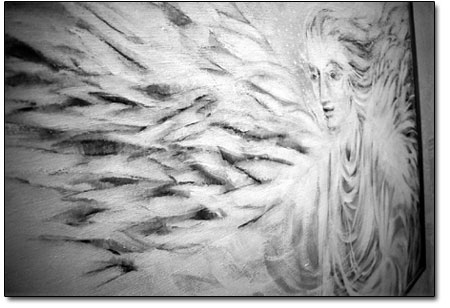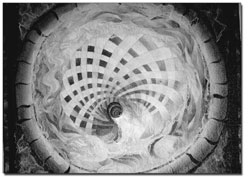|
| ||||||
| ‘Visual Expressions of the Sacred’
by Jules Masterjohn Fall is such a potent time for contemplation. Especially in the late fall, as the last bit of life and light barely hang on. The verdant green of the summer is only a memory as cool colors have shift from warm to hot reds and yellows, eventually burning themselves out to dusty brown. With these visual reminders of the inevitable cycle of life, what better time for the Sacred Arts Festival hosted by St. Mark’s Episcopal Church? In its forth year at St. Mark’s in Durango, the festival brings together sacred poetry, music and a labyrinth walk as well as a juried art exhibition. What is sacred art? In 1911, influential Russian painter and educator Wassily Kandinsky wrote of the power of visual art, through the portrayal of harmony and balance, to bring us to the sacred. For Kandinsky, abstract geometrics and primary colors stripped the world of its trimmings and trappings, evoking the sacred reality that underlies the material world. “A painter who finds no satisfaction in mere representation, however artistic … cannot but envy the ease with which music, the most nonmaterial of the arts today, achieves this end. He naturally seeks to apply the methods of music to his own art. And from this, results that modern desire for rhythm in painting, for mathematical, abstract construction, for repeated notes of colour, for setting colour in motion.” Of all the artists participating in the shows, closest to Kandinsky in this intention is Durango’s Alison Goss, whose fabric quilts are included in “The Sacred” exhibit at the Durango Arts Center. Geometry, spirals, sound waves and quantum physics all inform her work. Her large quilts anchor the show in the gallery and offer a soothing yet fully engaging experience. In “Touching the Infinite,” Goss depicts a large spiral with tendrils flowing out into the vast indigo blueness that one intuits as the Cosmos. The spiral shape seems to unfurl, suggesting expansion and entropy. The outward energy causes some viewers to step back a few paces as to not be overwhelmed by its force. In contrast, “Awareness,” with its central circle, is like a portal drawing one in and down a “rabbit hole” filled with shimmering rays, sinewy ribbons and iridescent strands. Goss writes that she has “broadened her bandwidth to tap into the infinite field of possibilities.” She uses meditation techniques to “align the head and the heart,” and in the process, finds entry into an ever-present yet, for most of us, unfathomed world. Her quilts, though intended to hang on the wall like paintings, also serve their traditional purpose, though not literally. Goss’ quilts wrap us in the warmth and security of knowing that we are all connected to something larger than ourselves, something that is within every cell of our beings, something sacred.
Other artists, too, use science and concepts from advanced technologies to illustrate energetic relationships in cosmic proportions. In the ICONS exhibit, Mike Kingan offers two pictures of the unperceivable energy patterns of sound vibrations. He uses mathematics software that simulates the geometries found in music and creates interesting images that make for provocative musing. Jana Parks’ intimate acrylic painting, “Cosmic Birth,” looks a bit like a Hubble photograph showing the birth of a solar system, as new heavenly bodies are blown from a black hole. The pinkness representing the cosmic matter brings to mind human flesh, linking the personal with the universal. Another image of sacred feminine energy is delivered by Adele Kurtz, whose acrylic painting, “The Belly of the Mother,” portrays a deep, hot-red center below the earth’s surface. She writes, “Two trees bow placidly over a deep chasm in winter-like hibernation while inside Mother Earth, the roaring lifeblood reminds us that, despite appearances, Universal Energies are directed toward the greater good.” Judith Reynolds’ acrylic painting, “Annunciation,” takes us in another direction entirely, reminding us of another coming winter. Within a field of near total white, a female angel Gabriel hovers, face calm and strong, holding out a branch of the slightest green. The branch – some of the only color found in the painting – symbolizes knowledge, and a redemptive blueness finds its way to the painting’s surface through the feathery whiteness of the angel’s wings. Reynolds writes, “The angel Gabriel interrupts the young Mary to announce that she will bear the Son of God. It’s clearly earth-shattering news, one of those pieces of information someone brings to you that transforms your life. Perhaps that’s why the story interests me – a human moment of extreme importance.” Reynolds transforms this Biblical story into a present-day tale that many of us have experienced as we live and grow through our unexpected challenges. As with Reynolds’ painting, Paul Boyer’s photograph “Be Still” calls attention to our human vulnerability. Boyer has captured a lone, naked man standing on a bit of coral surrounded by calm ocean waters. The figure, dwarfed by the sea, is totally bare and exposed yet does not seem out of place. This is a provocative portrait of trust in oneself and faith in the world. Within these two exhibits, many various interpretations of the sacred can be seen. Artists find “the sacred” in many forms: from nature and the human body to religious icons, cosmic events and purely abstract color and form. In these subjects, deeper concerns can be sensed – glimpses of transcendence, of salvation, of the inner workings of the physical world, and of God. Through art, we humans explore and express our place amidst the vastness of the universe, creating images that fill the mind and stir the soul. •
|




